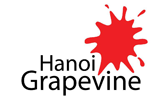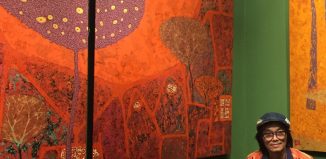”Foliage II” – A Must-See Exhibition if You Haven’t!
Written by Út Quyên for Hanoi Grapevine
“Foliage II” (taking place from 09 June – 15 July 2018) is the continuation of “Foliage” – an exhibition which affirms VCCA’s “brand name” as a center for contemporary art which hopes to spread the passion of creativity from young artists to the public, said the organizer.
It would be a waste of time in trying to connect all the artworks in the exhibition to define a common story or message in “Foliage II” because: “We don’t have any story” – said curator and VCCA’s art director, Mizuki Endo. The Foliage II’s core spirit is “to open the door for innovative and diverse modes of expression: self-reflection, self-examination, with an intersection for mutual understanding between the artists and the audience as well as among artists themselves.” Therefore, let’s stop associating, and leave your steps led by the curator through the exhibition to enjoy each artwork as an independent piece and in its interaction with the space around.
At the entrance, viewers might be easily attracted by three blue and white glazed pottery vases with very delicate hand decoration by Trieu Minh Hai which are exhibited in the Window Display room. A passer-by might looks forward to seeing an exhibition of Bat Trang ceramics with modern decorative style. However, once you step into the exhibition space, there is no more pottery.

Instead, you will encounter four paintings in naïve expressionism style by Nguyen Nghia Cuong. The squiggly brushstrokes and awkwardly shaped figures in these paintings might easily lead viewers to think that they are the result of negligence. But if you stop long enough to feel, you might enjoy the playful and lovely colors in the Love Garden, and be amused by gossips told in The Shade of a Coconut Tree. The painter tries to give neither judgment nor critics. He simply transmits to viewers a sense of amusement and playfulness through a humorous and witty eye.

Next to Nguyen Nghia Cuong paintings are two artworks by the well-established painters: Pham An Hai – renowned for his abstract style, and Pham Binh Chuong – well-known for his hyper realistic works.

The rest of the exhibition under the ingenious arrangement of curator Mizuki Endo’s is very pleasant to the eyes. Each artist is dedicated to a separated space which leaves enough room for audience to breathe, to have time to ponder and interact with each artwork without being distracted and confused.
The room exhibits Ta Minh Duc’s two artworks: a video and an installation next to the entrance might be a bit hidden from the viewers’ sight if they don’t pay enough attention. The young artist’s video work: House-building adversity is pretty eye-catching with against-light image of the dried trees in the foreground which are often used to support the construction, underneath those are the two cock fighters which are fighting back and forth, and a yellow bulldozer quietly moving in and out at the background. Without the presence of humans and a house under construction, these details alone are enough for viewers to relate to the culture beliefs and worship rituals in building new house of Vietnamese people, and therefore raise a feeling of hope and expectation for a new home and premonition of unexpected bad luck. Unfortunately, the artwork’s description (if anyone reads before seeing the work itself) restrains viewers from any association by a very long and unrelated introduction. Not to mention the description of the Ghost Grasshopper which seems not to fit at all to the work being displayed.

Three oil painters with realistic style are introduced in the exhibition are Ha Phuoc Duy, Vu Ngoc Vinh, and Luong Trung bring artworks with fine painting technique. The arrangement of paintings by Ha Phuoc Duy, Vu Ngoc Vinh on the same wall while placing Luong Trung’s works into a separated corner is a clever choice. Both Luong Trung’s and Vu Ngoc Vinh’s paintings are characterized by good figurative technique, sharped style and the ability to depict character’s expression and have the same concerns to contemporary topics such as: the crowdedness and crampedness of space but lack of humanity in urban life and the early grown-up children in Luong Trung’s paintings; the ludicrousness and coarseness of the emerging affluent class, the curiosity, contempt and taking amusement from human suffering, and the tension in family life in Vu Ngoc Vinh’s works. If placed next to each other, the two artists’ works would likely fight for viewers’ attention and make them feel uncomfortable for the thorny feeling and the tension that they bring.

The Sky Dome area seems to be an appealing stopping point. An installation of small earthenware coffins placed right in the middle of the dome with a series of lacquer paintings on rounded panels hanging on one side of the dome, the two also rounded terracotta works and a painting of Buddha on the other side cover the space with a vague brown color and gives it a sense of harmony. However, if looking closely at each artwork you might see the series of paintings by Vu Duc Trung seems a bit faint because there is no breakthrough in terms of idea, and the artist’s lacquer techniques just stop at “skillful”. Nguyen Duc Phuong’s works look attracting at first by the arrangement of the coffins covered by countless decorative drawings on theirs surface. But the voracious details and equivocate arc shape of the installation make the viewer confused about what the artist wants to emphasize. The painting of the Buddha hanging on the wall is difficult to relate to the installation, if it is part of the work; and is very disconnected in the whole space if otherwise.

On the wall at the other side of the Sky Dome, Pham Ha Hai’s abstraction paintings is easily overlooked, since viewers will be attracted to the music of the Hallelujah and want to quickly enter the room where displays a field installation work by Le Phi Long. Of all 34 works exhibiting at the Foliage II, “The House of God” might be the most engaging and interactive work to viewers. The small room is overwhelmed by the ruins of an old church bell tower. A video of the work in the field brings viewers back to the space where it was originally installed. Unfortunately, this video lacks the sense of obsession and abstract to support the actual installation. Viewers can interact with the work by going around, creeping into the empty gaps between the debris of the scattered structure on the floor and reading the inscriptions in white chalk which intermittently appear and occasionally repeat themselves like the faded dying words, while fragments of yellow fabric which conjoin the bell tower structure and especially the big capitalized yellow text: HIC DOMUS EST DIE is written on the wall are too clean, too neat and too brilliant, like a voice of a godly power that still wants to assert its uniqueness, intensity, and domination.

The last corner of the space displays a series of five paintings by Trieu Minh Hai which is very sophisticatedly drawn in pencil and ink on canvas. To the surprise we might see, the series in the contrary to its title: In the chaotic area, brings viewers feeling of calmness. Maybe it’s because we need to clear our mind in order to concentrate on the various associations this artwork might bring. Compared to all other works displayed in this exhibition, Trieu Minh Hai’s series of paintings is perhaps the work which eliminates formality the most and therefore, evokes the most emotions in each viewers.


It can be said that the Foliage 2 is one of the most worth-to-see exhibitions by VCCA thought out its one year of operation. The exhibition has achieved some of the goals set out by curator Mizuki Endo: “To become a new paradigm of sharing, where there is a deep understanding of the aesthetic objects, the differences and the meaningful oppositions,” as well as by Pham An Hai, who together with Mizuki, selected 10 artists for this exhibition: “To present to the public the young and promising artists who can to go much further in the future.”
















